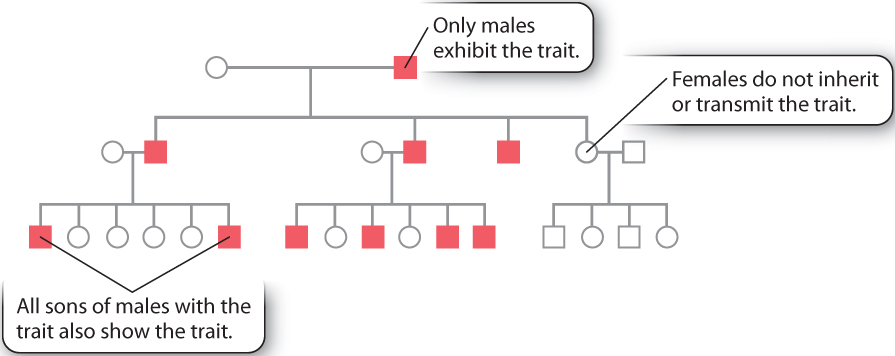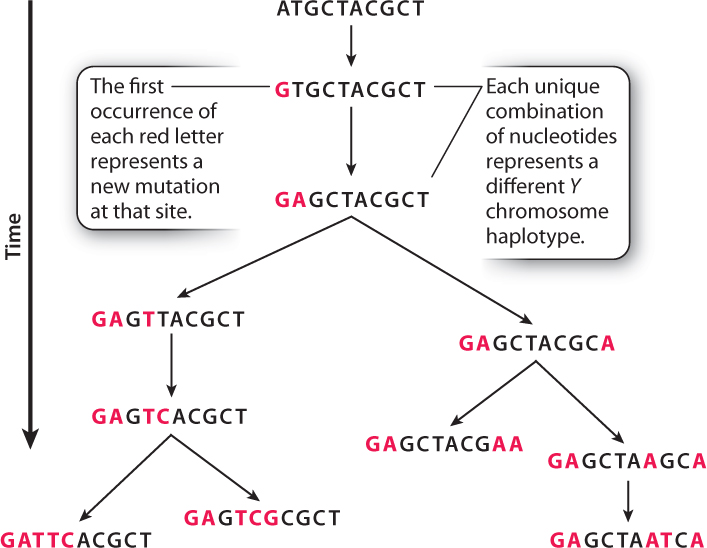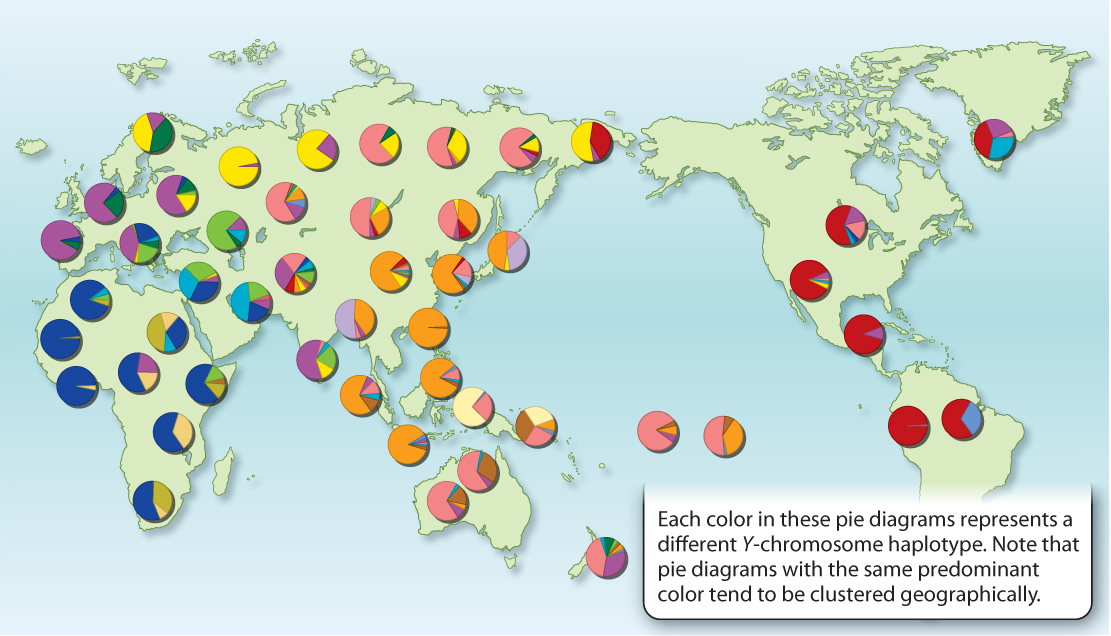17.4 INHERITANCE OF GENES IN THE Y CHROMOSOME
Like the X chromosome, the Y chromosome exhibits a particular pattern of inheritance because of its association with the male sex. In humans and other mammals, all embryos initially develop immature internal sexual structures of both females and males. SRY, a gene in the Y chromosome, encodes a protein that is the trigger for male development. (“SRY” stands for “sex-determining region in the Y chromosome.”) In the presence of SRY, male structures complete their development and female structures degenerate. In the absence of SRY, male embryonic structures degenerate and female structures complete their development. The SRY gene is therefore the male-determining gene in humans and other mammals.
Because they are linked to SRY, most genes in the Y chromosome show a distinctive pattern of inheritance different from that Mendel observed. In this case, they are passed from father to son.
17.4.1 Y-linked genes are transmitted from father to son to grandson.
Genes that are present in the unique region of the Y chromosome (the part that cannot cross over with the X) are known as Y-linked genes, of which there are not many. As well as the SRY male-determining gene, they include a number of genes in which mutations are associated with impaired fertility and low sperm count.
The pedigree characteristics of Y-linked inheritance are striking (Fig. 17.13):
- Only males are affected with the trait.
- Females never inherit or transmit the trait, regardless of how many affected male relatives they have.
- All sons of affected males are also affected.

Because the Y chromosome is always transmitted from father to son (and never transmitted to daughters), a trait determined by a Y-linked gene will occur in fathers, sons, grandsons, and so forth. Traits resulting from Y-linked genes cannot be present in females nor can they be transmitted by females. However, other than maleness itself and some types of impaired fertility, no physical traits are known that follow a strict Y-linked pattern of inheritance. This observation emphasizes the extremely low density of functional genes in the Y chromosome.
Case 3 You, From A to T: Your Personal Genome
17.4.2 How can the Y chromosome be used to trace ancestry?
The example of Claudia Gilmore illustrates how, through tests of her personal genome with regard to the BRCA1 and BRCA2 mutations, she became aware of her elevated risk of breast cancer. Your personal genome not only can tell you about your genetic risk factors for disease, but it also contains important information about your genetic ancestry. For example, your male ancestors can be traced through your Y chromosome. The regions at the tips in which the X and Y chromosomes share homology is only about 6% of the entire length of the Y chromosome. This means that 94% of the Y chromosome consists of sequences in which genetic linkage is complete because it does not pair with another chromosome and does not undergo crossing over.
Because of this complete linkage, each hereditary lineage of Y chromosomes is separate from every other lineage. As mutations occur along the Y chromosome, they are completely linked to any past mutations that may be present and also completely linked to any future mutations that may take place. The mutations therefore accumulate, and this allows the evolutionary history of a set of sequences to be reconstructed.

Fig. 17.14 shows an evolutionary tree based on the accumulation of mutations at a set of nucleotide sites along the Y chromosome. Because the nucleotide sites are completely linked, the nucleotides shown need not be adjacent but can be anywhere along the Y. Each unique combination of nucleotides constitutes a Y-chromosome haplotype, or haploid genotype. In the figure, the most ancient Y chromosomes are at the top, and the accumulation of new mutations as the generations proceed results in the successive creation of new haplotypes. Each Y-chromosome lineage may leave some nonmutant descendants as well as some mutant descendants, and hence any or all of the sequences shown may coexist in a present-day population.
In human history, the mutations creating new Y-chromosome haplotypes were occurring at the same time as populations were migrating and founding new settlements across the globe, and so each geographically distinct population came to have a somewhat different set of Y-chromosome haplotypes. The differences among populations are offset to some extent by migration among populations, which mixes the geographical locations of various haplotypes. Nevertheless, the fact that the mutations accumulate through time and are completely linked allows the evolutionary history of the haplotypes to be reconstructed. It also enables Y chromosomes to be traced to their likely ethnic origin.
The worldwide distribution of real Y-chromosome lineages among human populations is shown in Fig. 17.15. The different colors in the pie diagrams represent different mutations. Neighboring populations tend to have more closely related Y chromosomes than more distant populations. Four major clusters of Y-chromosome lineages can be recognized in Fig. 17.15. One is concentrated in Africa, another in Southeast Asia and Australia, a third in Europe and central and western Asia, and the fourth in North and South America. These clusters correspond roughly with the spread of human settlements around the globe inferred from archaeological evidence.

The implication of Fig. 17.15 is that the haplotype of your Y chromosome (if you have a Y chromosome) contains genetic information about its origin. And you can learn what this information is from genetic testing companies that sell direct-to-consumer (DTC) services. Their tests are not regarded as medical devices and so are unregulated, and quality control is sometimes uncertain. Nevertheless, you can send saliva or other biological samples to a DTC provider, which will (for a fee) test your Y chromosome and send you a report that details its possible origin. Of course, because of recombination and independent assortment of genes in other chromosomes, the ethnic origin of your Y chromosome may have little or nothing to do with the ethnic origins of genes in any of your other chromosomes.